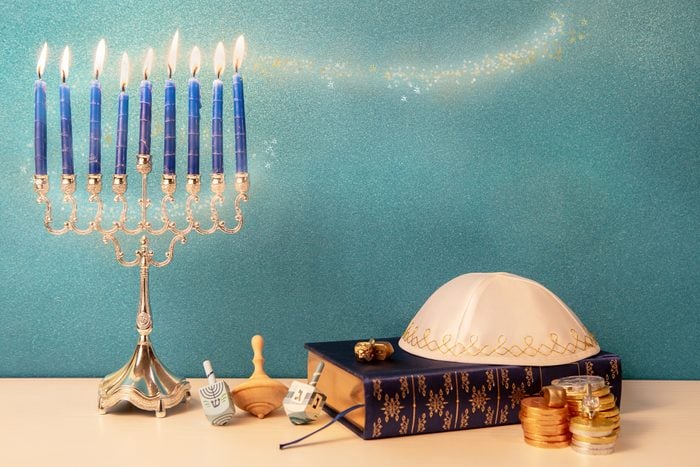
The tradition of Hanukkah colors
Think about Christmas colors, and your mind goes straight to red and green. Halloween colors are all about orange and black, while Thanksgiving gets dressed in the colors of autumn leaves. Even Mardi Gras sticks to a color scheme, with purple, yellow and green decorating the day. So it should come as no surprise that there are specific colors tied to Hanukkah (or Chanukah) as well. And these Hanukkah colors weren’t chosen at random; there’s a meaning behind the Hanukkah colors you see during the holidays.
Before you find out what the Hanukkah colors are (and why), you might want to brush up a bit on the holiday itself. Start with learning what Hanukkah is, then get the history behind menorah candles and some Hanukkah traditions. And in case you’re wondering when Hanukkah starts or how to wish friends and family a happy Hanukkah, we’ve got you covered.
Read on for information about Hanukkah colors that you’re sure to find fascinating, whether you celebrate Hanukkah, Christmas, Chrismukkah, Kwanzaa or any other holiday.
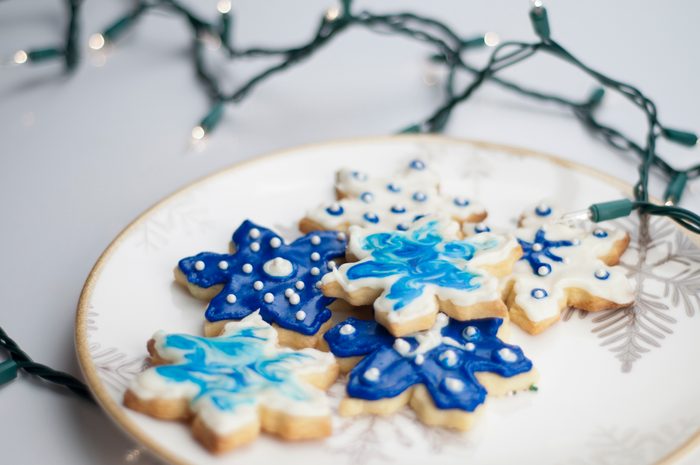
What are the traditional colors of Hanukkah?
Walk into stores in December, and you’ll be hit in the face with Christmas colors, but you may spot Hanukkah colors as well. If you’re shopping for Hanukkah decorations, gifts or wrapping paper, you’ll notice that most items are blue and white—sometimes with a touch of silver or gold. And while we’re so used to seeing those colors, they’re not a requirement. Think of them more as an enhancement or decoration.
“While there are no colors associated with Hanukkah in Jewish tradition, common colors associated with the holiday are blue and white,” says Rabbi Shlomo Litvin (aka the Bluegrass Rabbi), director of Chabad of the Bluegrass and the University of Kentucky Jewish Student Center.
So why are blue and white the de facto Hanukkah colors? The connection may have roots in poetry. In 1864, the Austrian Jewish poet Ludwig August Frankl called blue and white the colors of Judah in his poem “Juda’s Farben,” or “Judah’s Colors.”
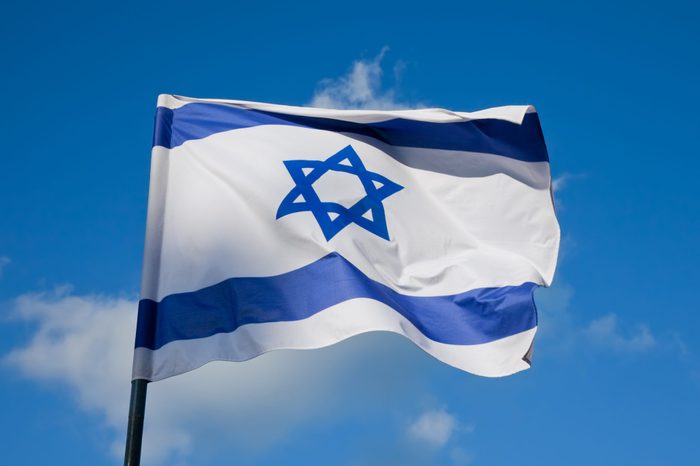
What do the colors of Hanukkah mean?
Plenty of people think of blue and white as Hanukkah colors (hence the number of Hanukkah crafts that feature them), but the combo is probably most recognizable from the tallit (or tallis), a prayer shawl worn (most often) by Jewish men every day and especially on special occasions, including Jewish holidays and life events like a bar mitzvah. You may also be familiar with the blue and white of the modern Israeli flag, which was designed in the late 1800s and implemented as the national flag of Israel in 1948. Separately or together, blue and white have always been meaningful colors for many of the Jewish faith.
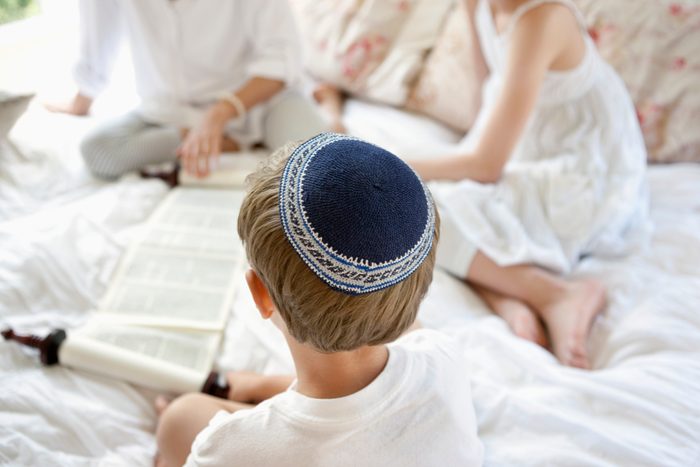
What does white symbolize?
“The color white in Judaism symbolizes purity,” says Rabbi Litvin. That’s why you’ll see Jewish brides in the color, though they’re far from the only ones who don the symbolic color. Observant Jewish men often wear a white garment called a kittel (it looks a bit like a cotton robe) on extremely spiritual holidays, including the Jewish New Year of Rosh Hashanah, Yom Kippur and the Day of Atonement. A white kittel might also make an appearance at the Passover meal known as the Seder—those leading the service might wear one.
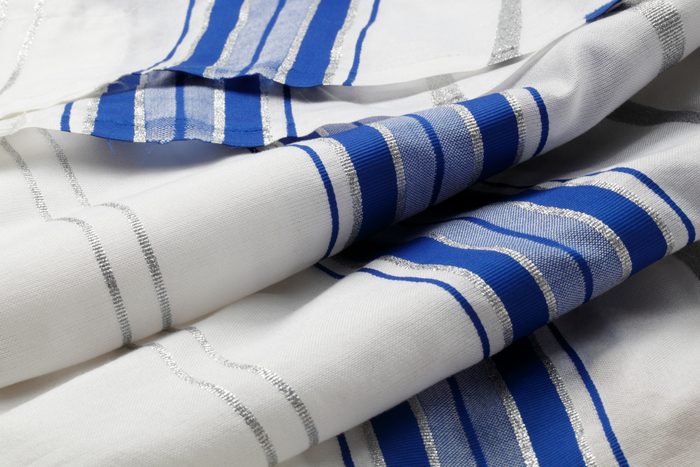
What does blue symbolize?
Though modern Jewish prayer shawls come in a wide variety of colors, with stripes ranging from classic blue or black to rainbow shades, the most traditional is white with bold blue stripes. And they have a fascinating history. Said to have been a blue or turquoise shade, the color was used in ritual garments or decorations. “The blue of the tallis, originally sourced from a small animal, can symbolize elevating nature in the service of G-d,” says Rabbi Litvin. Blue is also a color associated with the heavens and faith.
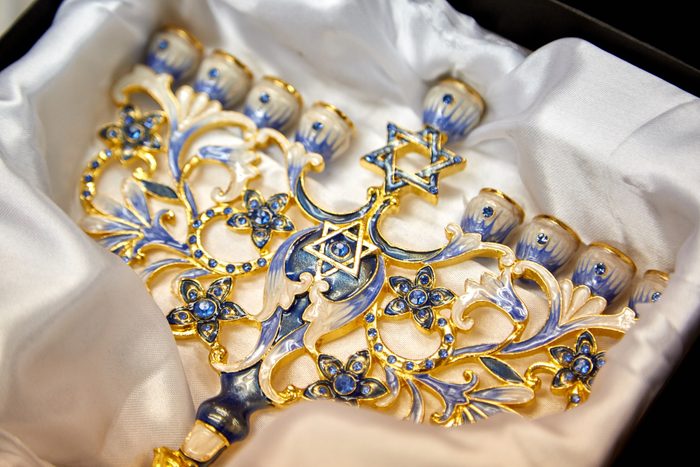
What do silver and gold symbolize?
Other common Hanukkah colors are silver and gold, both of which symbolize the menorah, a nine-branched candelabra that’s a centerpiece of Hanukkah. Traditional menorahs “were commonly made of precious metal and, for much of history, often one of the very few things of value Jewish families owned,” Rabbi Litvin says.
Another reason you’ll see silver and gold during the holiday is because of the “coins that were gifted to children, often on the fifth night, to increase their joy in the holiday,” he says. These days, you’ll often come across gold chocolate coins—referred to as Chanukah gelt, Yiddish for “Hanukkah money”—that serve as Hanukkah gifts for kids.
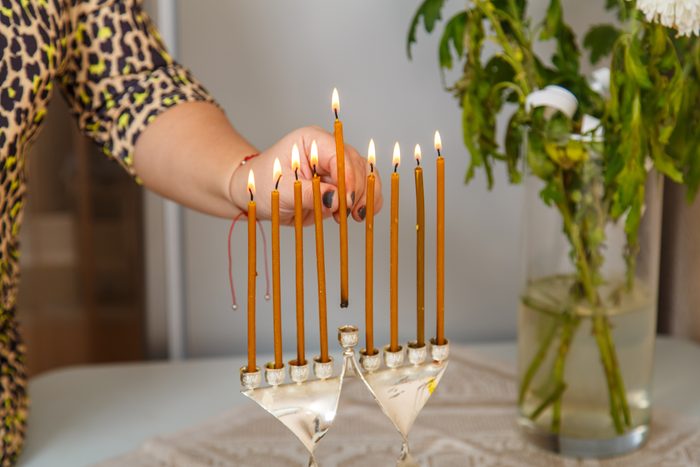
What are the Hanukkah candle colors?
In the story of Hanukkah, the candelabra was lit with olive oil—hence the miracle of the oil that lasted for eight days. But in modern times, Hanukkah candles are most often lit eight consecutive nights in a row, starting with a single candle and building up to eight candles on the eighth night. Rabbi Litvin points to the candles’ flames as one final inspiration for common Hanukkah colors. You might choose candles that are red, blue or gold for that reason. But those who celebrate may pick candles that match their decor or mood.
“Hanukkah is the Festival of Lights,” says Rabbi Litvin, noting that the menorah is “the world’s oldest symbol of religious freedom.” And the underlying theme of Hanukkah resonates with everyone—no matter their faith or level of observance. “The lights serve to remind us how easy it is to dispel darkness and how, when we work together, we can light up the world.”
Regardless of the colors used to celebrate, Rabbi Litvin says Hanukkah is a call on all of us to be the light amid the darkness.
Source:
- Rabbi Shlomo Litvin, director of Chabad of the Bluegrass and the University of Kentucky Jewish Student Center
